Cricket, the sport of baffling complexity and ancient tradition, boasts a veritable smorgasbord of rules certain to leave even the most passionate of fans scratching their heads. Among them all, however, none bewilders quite like the Law of Leg Before Wicket (LBW).
In this article, we delve into LBW's intricate inner workings to make sense of it all for newbies and enthusiasts alike. We don't just want you to know what it is; we want you to feel its crucial importance in every breath you take.
What Does LBW Mean?
Leg Before Wicket — abbreviated as LBW — is a rule that can get a batsman out in cricket. It does so under very specific circumstances. Let’s break down the meaning behind LBW as clearly and concisely as possible:
To start with, an LBW occurs when the ball hits a batsman's leg or body before hitting the bat. But not every hit results in an LBW dismissal. A few criteria must be met for one to occur:
Firstly, where does the ball land? An LBW is only applicable if the ball pitches (or lands) either in line with the stumps or outside off stump. If it pitches outside leg stump instead, then there can be no out for LBW on this occasion. This rule was put in place so that bowlers can't unfairly target players' legs.
Next comes where exactly on the batsman's legs it strikes. For an out-on LBW, the ball must hit him on his leg when considered against both where stumps are positioned and where the off stump stands relative to his body - but only if he wasn't trying to hit it with his bat at all. This incentivizes proper batting technique over using one's body as nothing more than a flesh wall.
Finally, how would it have moved? After striking the player's limb(s), the umpire must rule that the ball would have continued towards the stumps, had it not been for the collision. This part is crucial, as it ensures an even and fair balance between skilful bowlers and their bat-wielding counterparts.
The Basic Rules of LBW
Knowing even a little bit about Leg Before Wicket (LBW) in cricket is vital for both players and spectators. Here’s a quick rundown of the basic rules behind this confusing phrase:
- Where It Pitches: The first thing to consider when questioning whether or not something constitutes an LBW dismissal is where exactly the ball lands on its trajectory. For this to be relevant, it must pitch either directly in line with the stumps or outside off stump. If it pitches beyond the leg stump, however, there can be no out on LBW charges - this was put in place to ensure fairness by keeping bowlers from leering too closely at legs.
- Impact Point: Next comes where on a batsman’s body he gets hit. To be out on an LBW call, the ball has to strike him square in his thigh, shin, or somewhere else along his leg... but only if he wasn’t doing everything within his right mind to whack it with his bat. This encourages the use of proper technique instead of shielding your wicket by simply putting flesh in harm’s way.
- Direction It Travels: Lastly we come to the post-collision continuation path of said ball — essentially what would've happened if our friendly player hadn't gotten smacked by it? The umpire must decide whether or not it would have kept going until clattering into those all-important stumps. Factors like spin, swing, and bounce will all come into play when making this crucial judgement call which ensures that each player's abilities are given equal consideration
- No Shot Offered: If the batsman doesn't attempt a legitimate cricket shot, they are subject to an out condition. Even if the ball strikes them outside of the off stump, they can still be called for LBW. This rule pushes batters to play more actively.

The Role of Technology in LBW Decisions
With all decisions in cricket, technology plays a vital part when it comes to LBW. Here's how it helps umpires make better calls.
In cricket, Hawk-Eye is the go-to when it comes to ball-tracking technology. It shows where the ball went from the bowler's hand until it landed on the batter. It helps judges tell whether or not it would've hit the stumps for an LBW decision. By using line, speed and bounce data, Hawk-Eye gives a visual trajectory of what happened with that thrown leather sack. It's especially useful in instances where things are too close to tell just by looking at them.
UltraEdge is responsible for figuring out if a ball hit the bat before hitting its target — aka striking the batter’s body instead of their wood club thingy. The system uses sound waves and listens closely for any contact between ball and bat, no matter how quiet or slim that connection may be. Allowing this aspect into LBWs ensures that players who strike with their bat first cannot be called out on top of everything else.
Finally, there's DRS (Decision Review System). If teams think an umpire made a bad call, they can use DRS to challenge them. The system then uses both Hawk-Eye and UltraEdge as well for accuracy and fairness.
Of course, these technologies cannot make decisions on their dime — only humans can do that so far! Umpires implement what they learn from these systems into their final calls for a balance between raw human judgement and technological prowess.
How LBW Adds Strategic Depth to Cricket
Leg Before Wicket (LBW) is anything but a simple rule in cricket. It's a strategic element that has its hands all over the game. Let's see how LBW adds depth and excitement to cricket.
For bowlers, LBW is like an atomic bomb in their arsenal. A strong understanding of its mechanics helps them plan on how to trap a batter. Bowlers think up ways for balls to smack into the other player's pads and hopefully in line with the stumps.
This technique takes precision and skill. Quick throwers might aim for swing or seam movement to meet that pad, while spinners could mix up some turny bounce stuff instead. All this effort culminates until the batter either misses the ball entirely or can't hit it cleanly — increasing the chances of an LBW call.
As you could probably guess, batters want nothing more than to avoid falling victim to LBWs at all costs. They work on footwork and technique so they play with their club, not their legs. To do so, batters need to quickly judge where the ball will go and prepare for that hit accordingly. The moment a batter sees where it's going they must adjust their form efficiently and swiftly too. Besides these split-second moves though, good batters also practice fending off balls that could put them within reach of an LBW call while still trying for safe runs instead..
LBW also adds excitement for the spectators. When an LBW appeal is made by the bowler and fielders, everyone holds their breath. Fans watch intently to see if the batsman will live or die. The decision can change everything in a second, making it a thrilling moment.
Misconceptions about LBW
There are tons of myths about Leg Before Wicket (LBW) in cricket. But let’s make it clear:
- If the Ball Hits the Pad, It's Always LBW: This is not true at all. For an LBW decision to be made, several conditions must be met regarding how the ball was pitched and where it would’ve landed after hitting the batsman. So no, just hitting the pad isn’t enough.
- LBW If the Ball Doesn't Hit the Bat First: Similarly to the above, this myth is unfounded. The umpire still has to consider specific details on top of whether or not it hit the bat first too!
- The Batsman is Always Out LBW if Struck Outside the Stump: Not necessarily. If the batsman is attempting a shot and gets hit outside the line of the off stump, they cannot be given out LBW, assuming the ball is pitched outside the line of the off stump.
- Height of the Ball Impact Doesn't Matter: Height is a crucial factor. A ball striking the batsman above the knee roll can still lead to an LBW decision if it's projected to hit the stumps. Umpires take the height of impact into account when making their decision.
- LBW Decisions Are Just the Umpire's Perception: While the umpire's judgment is key, technology like Hawk-Eye now aids in making more accurate LBW decisions. This technology provides a clear trajectory of the ball, helping in the decision-making process.
The Impact of LBW on Different Formats of Cricket
The Leg Before Wicket (LBW) rule has a varied impact across the different formats of cricket, each with its unique style and pace.
In Test cricket, LBW plays a crucial and strategic role. This longer format allows bowlers more time to plan and execute their deliveries, often focusing on setting up a batsman for an LBW dismissal. For batsmen, it's a test of patience and technique to avoid getting out LBW over extended periods at the crease. The slower pace of Test matches provides more opportunities for bowlers to exploit a batsman's weakness against certain types of deliveries, increasing the likelihood of LBW decisions.
In One Day Internationals (ODIs), the impact of LBW shifts slightly. While still important, the faster pace and limited number of overs change the dynamics. Batsmen are under pressure to score quickly, which can lead to mistakes and more chances of LBW dismissals. Bowlers in ODIs often use variations in pace and swing to trap batsmen LBW, particularly during the middle overs where building pressure is key.
Twenty20 (T20) cricket, being the fastest format, sees a different impact of the LBW rule. Though LBW dismissals occur, they are less common compared to other forms of dismissal. In T20, batsmen's aggressive approach and focus on rapid scoring often lead to them being out in ways other than LBW. However, astute bowlers can use LBW to their advantage, especially against batsmen prone to playing risky shots across the line.

LBW and the Art of Bowling
In cricket, mastering the art of getting a batsman out LBW is a key skill for bowlers. LBW, or Leg Before Wicket, adds a significant strategic layer to bowling. Here's how bowlers use LBW to their advantage.
Fast bowlers often aim to swing or seam the ball in such a way that it traps the batsman in front of the stumps. They focus on pitching the ball in line with the stumps or just outside the off stump. This makes it harder for the batsman to hit the ball with their bat, increasing the chances of an LBW dismissal. Fast bowlers also use their pace to surprise batsmen, leading to late reactions and potential LBW situations.
Spin bowlers, on the other hand, use turn and bounce to their advantage. They aim to deceive the batsman with the spin of the ball, making it difficult to judge the line and length. A well-delivered spin ball can lead to the batsman misjudging the trajectory, hitting their pads, and being in danger of an LBW dismissal.
For both types of bowlers, understanding a batsman's technique is crucial. They study batsmen's weaknesses and tailor their deliveries to exploit them. For instance, if a batsman is weak against inswinging deliveries, a fast bowler might focus on bringing the ball into the batsman to increase the likelihood of an LBW.
The challenge for bowlers is to maintain accuracy and consistency. Every ball bowled to get an LBW dismissal must be precise. This requires skill, practice, and a deep understanding of the game's mechanics.
Batting Techniques to Counter LBW Dismissals
Batsmen in cricket need effective techniques to counter the threat of leg-before-wicket (LBW) dismissals. Here are some key strategies they use:
- Improving Footwork: Good footwork is crucial. Batsmen work on moving their feet swiftly and accurately towards the line of the ball. This helps in playing the ball with the bat rather than getting hit on the pads.
- Playing Straight: Batsmen focus on playing the ball straight back down the ground. This reduces the risk of missing the ball and getting hit on the pads in line with the stumps.
- Judging the Line and Length: It's vital for batsmen to quickly judge the line and length of the ball. This helps them decide whether to play forward or back, reducing the risk of an LBW.
- Practising the Leave: Knowing when to leave a ball is important. Batsmen practise judging balls that are going to miss the stumps, especially those outside the off stump, to avoid playing unnecessary shots.
- Solid Defensive Technique: A strong defensive technique is key. Batsmen work on defending solidly with the bat close to the pad, which helps in covering the stumps and reducing LBW chances.
- Playing Spin Effectively: Against spinners, batsmen practise playing late. This means waiting for the ball to come to them, which helps in reading the spin and playing it more effectively.
By mastering these techniques, batsmen can significantly reduce their chances of being dismissed LBW. It requires constant practice, a good understanding of one's own game, and the ability to read the bowler's intentions. Effective batting against LBW is not just about defensive play; it's about making smart, calculated decisions at the crease.
Conclusion
In summary, the LBW rule is a fascinating aspect of cricket, embodying the sport's strategic depth and technical precision. Understanding the nuances of LBW not only enhances one's appreciation of the game but also brings to light the intricate balance between batting and bowling. As cricket continues to evolve, the LBW rule will undoubtedly remain a central and compelling part of this beloved sport.
For more information:


